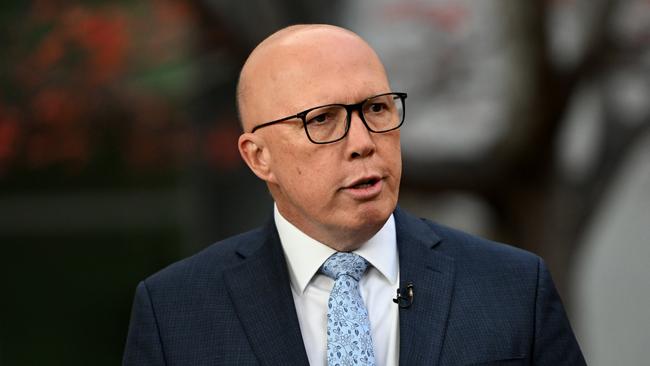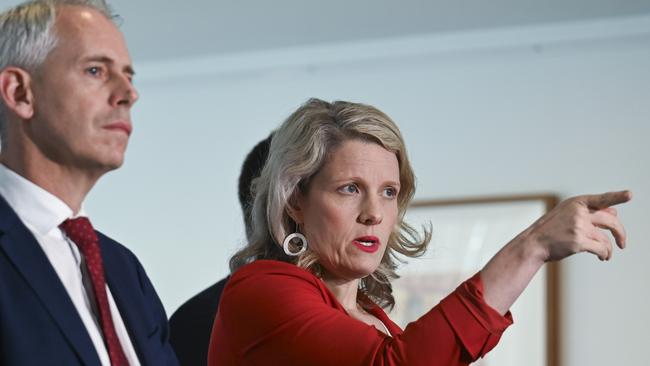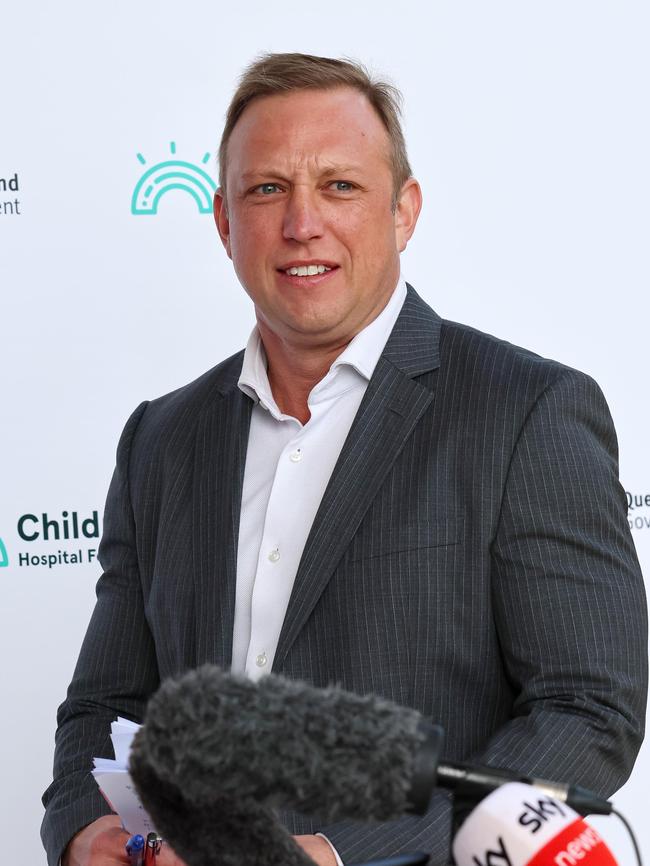Slashing skilled migration to fix housing? Tell Peter he’s dreamin’
Would Dutton’s proposed 25 per cent cut to the permanent migration intake solve the housing crisis? Tell him he’s dreamin. But the opposition is gaining traction as Labor bears the blame.

Yet the fact the Coalition has any traction at all is testament to the public’s distrust of politicians in this policy area and rising community angst about housing, congestion and a loss of border control given the record post-pandemic influx of foreigners.
Like it or not, the Albanese government is bearing the blame – even for many of the serial failings of the previous tenants. The High Court’s decision in November last year to rule the federal government’s use of indefinite detention was unlawful and unconstitutional may be totally unrelated in a policy sense, but it has unsettled the community with more than 150 asylum-seekers released from detention.
Home Affairs Minister Clare O’Neil, Immigration Minister Andrew Giles and Attorney-General Mark Dreyfus have been catching the flak for Labor’s wobbles over a wicked problem. Voters are highly sceptical that Canberra has control over immigration after bipartisan failures in screening, settlement, housing, higher education, regional development and infrastructure delivery. No one in their right mind thinks a migrant inflow of almost 550,000 in the year to September is desirable, let alone sustainable.

It also has become clearer to many that migration-fuelled growth is a double-edged sword; it adds to supply and demand, pumps up the size of the economy, but exacerbates the softness in per capita incomes and the post-pandemic inflation, especially for housing and other services. The Reserve Bank is watching for signs of further population pressures as it finetunes its interest rate response amid a lingering inflationary pulse.
More than a year ago, Martin Parkinson’s migration review documented a broken system, due largely to Coalition mismanagement and wilful neglect, with a steady loss of public confidence in a program that was being gamed and exploited at every turn, while losing touch with the drivers of several generations of spectacular success since 1949.
The review provided a set of reform directions for Labor, which it formalised in December last year with the release of its Migration Strategy. It was a sound, holistic way forward, based on clear principles: a bias to permanency, skills in demand, English-language proficiency and medium-term planning targets across all levels of government.
But as the government works behind the scenes to bed down dozens of changes to highly complex machinery, bare-knuckle politics could see the country sliding back into sub-optimal choices. The people who were asleep at the wheel for almost a decade are peddling junk policy and the government is looking exposed, rather than pursuing its strategy like its political life depends on it.
In his budget in reply a week ago, the Opposition Leader proposed a one-quarter cut to the permanent intake next financial year, from 185,000 to 140,000 places, to take the pressure off housing.
Remember, this program is geared to skilled workers; next financial year, 71 per cent of places will be dedicated to this stream; the remainder is almost entirely for the demand-driven family component, for the spouses and children of Australian permanent residents. Most of the people who will get a permanent visa are already living here, so it’s difficult to see how slashing permanent migration can make anything other than a tiny difference to the housing shortage.
Naturally, the business lobby is aghast at the Coalition’s cheap ploy. Australian Industry Group chief executive Innes Willox says to cut the skilled component of the migration program would be “a momentous act of economic self-harm”. Other business leaders wondered where the engineers, teachers, nurses and other occupations we need in coming years would come from. Treasury has estimated the net lifetime fiscal contribution of a skilled migrant is north of $200,000.
More curious was the response of Queensland Premier Steven Miles, who backed the Coalition’s proposal on the permanent program and a doubling down by Dutton, who went on to offer 160,000 as a target for net overseas migration (which, by definition, means the temporary component of students and foreign workers would be slashed to 20,000 from a forecast 205,000 this financial year). The Labor premiers of Victoria and Western Australia, where population is growing at 2.9 per cent and 3.3 per cent, respectively, rejected the Queenslander’s arguments.

Miles may be facing an election in October, but that’s no excuse to act like a dill. The state is on an infrastructure binge, trying to deliver Olympic Games projects; it is a magnet for ageing southerners and young families. If any state needed skilled foreign workers in construction and social services, it’s Queensland. Yet last financial year the state with one-fifth of the nation’s population secured only one in eight of the record 142,344 permanent skilled migrants.
As Parkinson identified, the permanent program is a nation-building lever, but the overall numbers have been swamped by temporary settlers, many of whom keep changing visa categories so that we have a huge cohort of “permanently temporary” residents. This is where the reform action needs to take place and, as O’Neil insists, is taking place. At the end of March there were 2.83 million foreigners here on temporary visas. That’s about 1.2 million more than before the Morrison government began the staged international border reopening in November 2021.
About 600,000 people arrived in the first three months, including “to reunite with loved ones, work or study”, as a government press release put it at the time. Ahead of the May 2022 election, business was demanding more workers, especially in areas of dire need such as hospitality and the building trades.
The number of foreigners here on student visas has doubled since the reopening, hitting a record 713,000 in February; the number of those on temporary graduate visas has more than doubled to just under 200,000; the number of temporary workers and backpackers has tripled to 509,000.
The surge in such a short time was astonishing. No one was prepared for the rush because temporary migration is largely out of our control. In Josh Frydenberg’s final budget in March 2022, Treasury forecast arrivals in 2022-23 would be 490,000, with 310,000 departures, for a net inflow of 180,000.
The latest estimates from the Australian Bureau of Statistics shows there were 741,000 arrivals and 213,000 departures leading to a record financial year net overseas migration of 528,000. It was a monumental miss; even two subsequent Treasury updates were wildly short of the mark.
Anthony Albanese came to office two years ago with businesses crying “skills crisis” and a huge pandemic era backlog of visa applications. The political heat Labor confronts is essentially one part policy, one part providence. Whoever won the election would have to deal with the coming population bomb, unforeseen by officials.
But Labor also unlocked the handbrake of visa processing, employing an extra 600 departmental workers and spending tens of millions to clear the backlog. It was also slow to scrap pandemic-era visa extensions or crack down on abuses in the education sector, where too many who come here are not bona fide students.
Tightening up on rorts, tighter screening of students, rising unemployment and a steady rise in the number of foreign graduates (and our own go-getters) leaving will start to close the gap between arrivals and departures to around 250,000. The government is supremely confident it has done enough and will hit the net migration figure, although confirmation of that won’t occur until six months after the next election, which is due by this time next year. O’Neil has released an action plan to go with Labor’s new road map.
There has been a tightening up on foreign student enrolments, tied to the provision of student accommodation, and other visa reforms such as significant increases to the financial capacity requirements for international students. Last year saw the return of the cap on student working hours (to 24 hours a week). From July there will be a reduction in how long former students can remain in Australia.
While there is busywork, key reforms are dragging on. For instance, the centrepiece of December’s announcement was a new four-year “skills in demand” visa, with full mobility and clear pathways to permanent residence, replacing the complex single employer sponsored Temporary Skill Shortage visa that business and unions said was not fit for purpose.
The new visa will be backed by three pathways, including specialist, core skills and lower-paid tiers, with legislated indexation of wage thresholds to maintain integrity. Yet that new system, with a rapid processing turnaround for the most desirable workers, won’t be in place until near the end of the year. How come? For some in business, this is dragging the chain when there are worker acute shortages in construction for homes and the energy transition.
Another key component of the strategy is a reformed points test “to better identify migrants who will drive Australia’s long-term prosperity”, according to the government. At the moment, this diagnostic tool to decide who gets to stay here permanently is a mess, leading to perverse outcomes.
The government has just released a discussion paper on the points test. Consultation is underway. But there’s no firm date set for implementing what O’Neil claimed six months ago was a fundamental reform where the potential benefits would be “massive”.
As well, a shift to longer horizon migration planning for better housing and service outcomes won’t happen until 2025-26.
To be fair, there is a lot happening to make the system less complex, more responsive to industry needs and have all levels of governments on board for what Parkinson has described as a “10-year rebuild”. A number of sources in the business and community sector would back O’Neil’s diligence and energy over anyone who has occupied the portfolio in a long time.
But hold the applause. The politics of now, with voters fretting over the effects of unsustainable population growth, demands a faster response and stronger narrative from the Prime Minister, Jim Chalmers and O’Neil. If Labor is so confident it has migration under control, let’s hear about it from the prime movers. Do they believe in this?
Bipartisanship on a migration strategy, as in areas such as tax, aged care and disability services, would supercharge the long-term national interest. It would, at the very least, reduce the likelihood of economic, social and cultural self-harm. Yet that’s a distant dream, as a low-calorie, divisive and harmful electoral contest looks more certain by the day.







Peter Dutton is retailing a simplistic migration fix that would damage Australia’s prosperity by limiting our access to the globe’s footloose entrepreneurs, skilled workers and future go-getters. The Opposition Leader’s sound bite of a policy is as foolish as it is simplistic, regrettably bringing into his fold the dumb and desperate in the provinces. “Smart state” be damned. Would Dutton’s proposed 25 per cent cut to the permanent migration intake solve the housing crisis? Tell him he’s dreamin’, as Darryl Kerrigan put it so eloquently in The Castle.